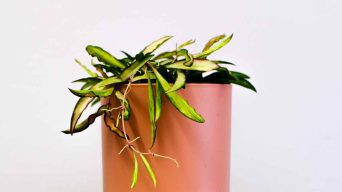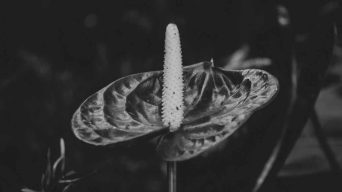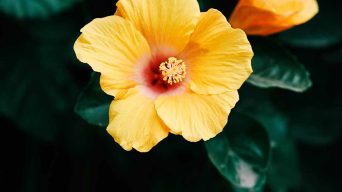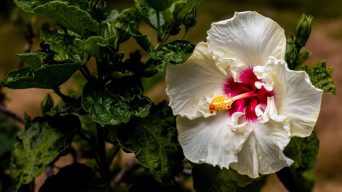Hibiscus plants are popular for their large, showy flowers but are susceptible to several problems.
One of the most common is underwatered hibiscus.
If your hibiscus plant is wilting, its leaves are turning yellow or brown, and the flowers are dropping off, it’s likely that it’s not getting enough water.
Although an underwatered hibiscus can be revived, it’s best to try to avoid the problem in the first place.
Here’s what you need to know about underwatered hibiscus, including how to identify it, treat it, and prevent it in the future.
Why Is Underwatering Hibiscus A Problem?
Underwatering is a problem for hibiscus plants because they are native to tropical climates.
This means that they’re used to high humidity and lots of water.
In their natural habitat, hibiscus plants would receive water from rain and dew daily.
They don’t have access to these same moisture sources when grown as houseplants.
As a result, it’s up to the gardener to ensure that the plant gets enough water.
If it isn’t, the plant will start to experience stress.
Water is essential for plants because it helps them to transport nutrients and minerals from the soil to the rest of the plant.
It also helps to keep the plant cool and create energy and food through photosynthesis.
When a hibiscus plant doesn’t have enough water, it can’t perform these essential functions properly.
This can lead to severe problems, such as:
- The plant may become susceptible to pests and diseases
- The plant may stop flowering
- Stunted growth
- The plant may eventually die
How Does Underwatering a Hibiscus Occur?
There are a few different reasons why a hibiscus plant might become underwatered.
The most common causes are:
Inadequate Watering
When hibiscus plants are grown as houseplants, they must be watered regularly.
Many people make the mistake of only watering their plants when the soil is dry.
However, this isn’t often enough for hibiscus plants.
They need to be kept moist at all times.
This means you should water them when the top inch of soil is dry.
Allowing the soil to dry out completely won’t be easy to rewet, and the plant may suffer.
Inadequate Humidity
Hibiscus plants also need high humidity to thrive.
Ideally, the air around the plant should be between 60% and 70% humidity.
If the air is too dry, the plant will start to experience stress.
There are several ways to increase the humidity around your hibiscus plant.
You can use a humidifier, water your plants with warm water, or mist them regularly with a spray bottle.
The best method will depend on the size of your plant and the environment that it’s in.
Hot, Dry Weather
Hot, dry weather can also cause hibiscus plants to become stressed.
If the air is too hot and dry, the plant will start to lose water faster than it can replace it.
This can cause the plant to become underwatered.
Water it more often to protect your hibiscus plant from hot, dry weather.
You may also want to mist it with water or move it to a cooler, more humid location.
Poor Drainage
Hibiscus plants need well-draining soil to thrive.
If the soil doesn’t drain properly, the plant will become waterlogged.
This can cause the roots to rot, eventually killing the plant.
To ensure that your hibiscus plant has well-draining soil, mix equal parts perlite, sand, and potting soil.
You can also add a gravel layer to the pot’s bottom to improve drainage.
Too Much Sunlight
Hibiscus plants need plenty of sunlight to flower.
However, too much sun can cause the soil to dry out too quickly.
If the soil dries out, the plant will become stressed and may start to experience problems.
To protect your hibiscus plant from too much sunlight, place it in an area with plenty of indirect light.
You can also add a sheer curtain or blind to the window to filter the sunlight.
Root-Bound
If a hibiscus plant becomes root-bound, it may start to experience problems.
Root-bound means that the plant’s roots have become so crowded that they cannot absorb enough water and nutrients.
As a result, the plant will become stressed and may start to experience problems.
To prevent your hibiscus plant from becoming root-bound, repot it every two years or so.
Use a pot that’s only slightly larger than the one it’s currently in.
This will give the roots enough room to spread out without being too cramped.
Pest Damage
Pests can also cause hibiscus plants to become underwatered.
Aphids, mealybugs, and scale insects are all common pests that attack hibiscus plants.
These pests suck the sap out of the plant, which can cause the plant to become stressed.
Pests can also damage the plant’s roots, making it difficult for the plant to absorb water.
To protect your hibiscus plant from pests, check it regularly for signs of infestation.
If you see any pests, remove them by hand or use a natural pest control method.
Disease Damage
Diseases can also cause hibiscus plants to become underwatered.
The most common disease that affects hibiscus plants is root rot.
Root rot is caused by a fungus called Phytophthora cinnamomi.
This fungus attacks the plant’s roots and prevents them from absorbing water.
Root rot can be difficult to treat, so it’s crucial to catch it early.
To prevent root rot, plant your hibiscus in well-draining soil.
You should also avoid overwatering the hibiscus plant.
How To Tell If Your Hibiscus Is Underwatered
It’s essential to know how to tell if your hibiscus is underwatered.
If you don’t catch the problem early, it can cause lasting damage to the plant.
That’s why it’s essential to familiarize yourself with the signs of an underwatered hibiscus.
Signs of an Underwatered Hibiscus
You can look for several signs to tell if your hibiscus is underwatered.
The most common signs include:
Drooping Leaves
If the leaves of your hibiscus plant are drooping, it’s a sign that the plant is stressed.
Several things can cause drooping leaves, but underwatering is one of the most common causes.
Drooping happens because the plant is not getting enough water can support the leaves’ weight.
If you see that the hibiscus leaves are drooping, check the soil to see if it’s dry.
If it is, water the plant immediately.
Yellow Leaves
If the leaves of your hibiscus plant turn yellow, it’s another sign that the plant is underwatered.
Several things can also cause yellow leaves, but underwatering is one of the most common causes.
When a plant is underwatered, the leaves will turn yellow and brown because the plant cannot transport nutrients to the leaves.
If you see that the leaves of your hibiscus are turning yellow, check the soil to see if it’s dry.
If it is, water the plant immediately.
Brown Spots on Leaves
If you see brown spots on the leaves of your hibiscus, it’s another sign that the plant is underwatered.
A lack of water causes brown spots.
When the plant doesn’t have enough water, the leaves will start to dry out and turn brown.
If you see brown spots on the hibiscus leaves, check the soil to see if it’s dry.
If it is, water the plant immediately.
Brown Leaf Tips
Brown leaf tips or edges are usually caused by a lack of humidity, not a lack of water.
Hibiscus plants like humid conditions, so if the air in your home is dry, it can cause the leaves to brown.
To increase the humidity around your hibiscus plant, use a humidifier or put the plant on a pebble tray.
If you see brown leaf tips or edges, check the soil to see if it’s dry.
If it is, water the plant immediately.
Leaf Drop
If the leaves of your hibiscus plant start to fall off, it’s a sign that the plant is stressed.
Several things can cause leaf drop, but underwatering is one of the most common causes.
When a plant is underwatered, the hibiscus leaves will start to fall off because the plant cannot transport nutrients to the leaves, causing them to die.
Curling Leaves
If the leaves of your hibiscus plant start to curl, it’s another sign that the plant is underwatered.
When a plant is underwatered, the leaves start to curl because the plant cannot transport water to the leaves.
This cause the leaves to curl in an attempt to prevent water loss.
Flower Drop
If the flowers of your hibiscus plant start to fall off, it’s a sign that the plant is stressed.
Several things can cause flower drop, but underwatering is one of the most common causes.
When a plant is underwatered, the hibiscus flowers will start to fall off because the plant is unable to transport nutrients to the flowers, causing them to die.
Dry or Cracked Soil
If the soil around your hibiscus plant is dry or cracked, it’s a sign that the plant needs water.
When the soil has been dry, it will start to crack.
This is because the water in the soil has evaporated, and the soil can no longer hold onto it.
If you see that the soil around your hibiscus is dry or cracked, water the plant immediately.
Slow Growth
If the growth of your hibiscus plant slows down, it’s a sign that the plant is underwatered.
When a plant is underwatered, the growth will slow down because the plant is unable to transport nutrients to the leaves and flowers.
Hibiscus plants need a lot of water, so if you see that your plant’s growth has slowed down, water the plant immediately.
How To Save an Underwatered Hibiscus Plant
If you think that your hibiscus plant is underwatered, there are a few things you can do to save it.
1. Water Deeply
When you water your hibiscus plant, make sure to water deeply.
Water the plant until the soil is saturated and the water runs out of the pot’s bottom.
2. Use Room Temperature Water
Make sure to use room temperature water when watering your hibiscus plant.
Cold water can shock the plant and cause the leaves to drop.
3. Soak the Plant
If the plant is really dry, you can soak the plant in a sink or tub of water.
Soak the plant for 30 minutes to an hour. This will help the plant to absorb the water it needs.
4. Use a Humidity Tray
If the leaves of your hibiscus plant are browning, it’s a sign that the air is too dry.
You can use a humidity tray to increase the humidity around your hibiscus plant.
A humidity tray is a shallow tray filled with water and pebbles.
Place the hibiscus plant on the tray and ensure the pot’s bottom is not touching the water.
The water will evaporate and increase the humidity around the plant.
5. Mist the Plant
Another way to increase the humidity around your hibiscus plant is to mist the plant with water.
Misting the plant will help increase the humidity and keep the leaves from drying.
6. Move the Plant
If the air around your hibiscus plant is too dry, you can try moving the plant to a different location.
Move the plant to a more humid room, such as the bathroom or kitchen.
7. Prune the Plant
If the plant is overgrown, you can prune it back to help it recover.
Pruning the plant will help it to focus its energy on new growth.
To prune the plant, cut back the stems to about 6 inches.
8. Check the Soil
Make sure the soil is light and well-draining.
If the soil is too dense, it will not allow the roots to breathe, and the plant will not be able to absorb water.
Mixing in some perlite or sand ensures that the soil is light and well-draining.
9. Repot the Plant
If the plant is rootbound, you can repot it into a larger pot.
Repotting the plant will give the roots more room to grow and help the plant absorb more water.
Ensure that you use a pot at least 2 inches wider and deeper than the current pot.
10. Be Patient
It will take some time for your hibiscus plant to recover from being underwatered.
Be patient and keep up with the watering schedule.
Do not let the plant dry out again, as this will prevent recovery.
How To Prevent Underwatering a Hibiscus Plant
With some care, you can prevent your hibiscus plant from being underwatered.
Here are a few tips on how to prevent underwatered hibiscus plants:
1. Check the Soil Before Watering
The best way to know if your hibiscus plant needs water is to check the soil.
Take a finger and insert it about an inch into the potting mix.
f the soil feels dry, it’s time to water the plant.
2. Water Deeply and Less Often
It’s better to water your hibiscus plant deeply and less often rather than watering it shallowly and more often.
Watering deeply encourages the plant’s roots to grow deeper into the soil, which makes the plant more drought tolerant.
3. Use Mulch
Mulch helps to retain moisture in the soil and keeps the roots cool.
Organic mulches, such as bark chips or straw, work best.
4. Group Plants Together
Grouping plants together helps to create a microclimate around the plants.
The group of plants will help to shade the soil and slow evaporation.
5. Protect Your Hibiscus Plant from the Sun
If possible, protect your hibiscus plant from the hot afternoon sun.
The ideal location for a hibiscus plant is in an east- or north-facing window.
6. Check the Drainage
Make sure that the pot you’re using has good drainage holes.
If the pot doesn’t have good drainage, the plant’s roots can become waterlogged, leading to root rot.
7. Don’t Let the Soil Dry Out Completely
While hibiscus plants are drought tolerant, they don’t like having their soil completely dry out.
Letting the soil dry out completely can stress the plant and make it more susceptible to pests and diseases.
8. Fertilize Regularly
Fertilizing your hibiscus plant regularly will help to keep it healthy.
Use a balanced fertilizer that is low in nitrogen and high in phosphorus.
9. Avoid Overwatering
Even though hibiscus plants are drought tolerant, they can be overwatered.
Overwatering can lead to root rot and other problems.
If you think your hibiscus plant is overwatered, allow the soil to dry out completely before watering it again.
10. Check for Pests and Diseases
Pests and diseases can stress a hibiscus plant and make it more susceptible to drought.
If you see any pests or diseases, treat them immediately.
Final Thoughts
While an underwatered hibiscus is a common problem, it is easily fixed with some knowledge and care.
Understanding the signs of an underwatered hibiscus can quickly correct the problem and get your plant back on track.
With proper care, your hibiscus will thrive and provide you with beautiful blooms for many years.







